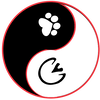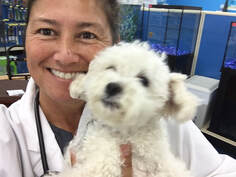 Dr. Wendy presented 2 papers at the 20th Annual International Conference on TCVM in November 2018 in Ocala. See Abstracts below. Full papers are published in Pain, Lameness, Neurological and Endocrine Disorders - TCVM Update through the Chi Institute bookstore TCVM for the Treatment of EPMAbstract Equine protozoal myeloencephalitis (EPM) is an important neurologic disease of horses most commonly caused by infection of the central nervous system by the protozoa, Sarcocystis neurona. Clinical signs can be focal or multifocal and are attributed to damage to neural tissues by invasion of the protozoa and concurrent inflammation. Many horses will test seropositive, however, only a small percentage will exhibit clinical signs which implies horses with a compromised immune system are susceptible to infection while horses with a healthy immune system are able to clear the parasitic infection without treatment. Traditional Chinese Veterinary Medicine theory views this disease pattern as a Zheng Qi Deficiency with Qi and Blood Stagnation. Premortem diagnosis in both Eastern and Western Veterinary Medicine involves a thorough neurologic exam and response to treatment. Treatment with acupuncture and herbal therapy alone or in conjunction with pharmaceuticals has a favorable prognosis. Food therapy and rehabilitation can assist the horse to return to full function. Recrudescence and reinfection when the immune system is challenged is a common sequela, therefore, long term care of EPM horses should include TCVM treatment during times when the Zheng Qi may be challenged. Using the Horse's Constitution to Treat "ADR"Abstract
Preventative veterinary medicine is an age old concept that is the basis of animal husbandry. As veterinary medicine continues to become more specialized, veterinarians delegate many of the preventative procedures; feeding, housing recommendations, parasite control, farriery, dental care, breeding and conditioning to paraprofessionals and caretakers. The majority of horse owners no longer come from agrarian backgrounds where husbandry practices for the local climate and forage was passed on from generation to generation. Media, funded by corporations that sell vaccines, pharmaceuticals, supplements and processed feeds, have become the largest source of educational material for our clients concerning the wellness of their horses. Many modern horses live in urbanized settings, have little turnout and are fed large amounts of concentrated feeds. Competition can be demanding due to travel, athletic expectations, emotional stress and artificial day lengths. Some horses are more sensitive to stress, temperature, training methods and foods. If we can recognize our patient’s weaknesses, we can be better equipped to help them. The 5 Element theory classifies a basic constitution of a horse and helps us recognize how a horse with a certain constitution reacts with his environment, lifestyle and rider. We can use the constitution to prepare a Traditional Chinese Veterinary Medicine treatment plan to support constitutional vulnerabilities to reduce the incidence of disease, lessen the risk of sports injury and keep the horse happy in its work. Educating our clients on basic care and wellness and considering constitution, diet, environment and seasonal factors will help our sporthorses stay strong in mind, body and spirit throughout their career.
0 Comments
ABSTRACT
Abstract of Thesis Presented to the Master Program of the Chi Institute in Partial Fulfillment of the Requirements for the Degree of Master of Science DETERMINING THE EFFECT OF LASER ACUPUNCTURE ON THE HEART RATE OF ACUTE-STRESSED HORSES By WENDY YING, DVM, TCVMP, CCRT AUG 2016 Committee Members Sam Wu, PhD Huisheng Xie, DVM, PhD Aituan Ma, MS, PhD Anxiety in horses affects performance, health and value of sport horses and the reputation of trainers and competitors. Current treatments include behavior modification with pharmaceuticals, acupuncture, herbal supplements, mineral supplements and food therapy. We propose laser acupuncture, given before stressful situations can decrease anxiety and improve performance and health in horses. A 2 day cross over study was performed on 24 horses who were either assigned to the treatment or control group on Day 1. Treatment horses were given laser acupuncture to reduce anxiety. Control horses were given sham treatment with the laser in the off position. All horses were fitted with a heart rate monitor and then exposed to an acute startle test (AST). Heart rate was monitored 1 minute pre and 10 minutes post AST. Peak HR and return to Baseline HR was noted. All horses were allowed a wash out period of 7 days and then assigned to the other group and results from both days were compared. 22 geldings and 2 mares ranging in age from 6 yrs to 29 yr were used. Breeds included Arabians, Quarter Horses, Warmbloods, Tennessee Walking Horses and grade horses. Disciplines included Jumpers, Hunters, Dressage, Driving, Fox hunting and Trail. Our data shows in some cases, laser acupuncture did reduce peak heart rate and decreased the time to return to baseline. Further research needs to be done with a larger group of subjects. Modifying the acute startle test depending on the level of anxiety of the breed/discipline may give more meaningful results. Quarter Horses, trail and driving horses showed a very low level of startle (ie lower peak heart rate) compared to dressage horses and jumpers probably due to their exposure to loud noises in their daily activity. This model may be used to test the effectiveness of other kinds of acupuncture treatments, herbal therapies, pharmaceuticals and supplements claiming to be effective in controlling anxiety in horses and other animals. 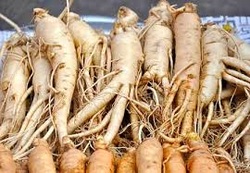 Herbal Medicine is an essential part of Traditional Chinese Veterinary Medicine. In China, TCVM treatment consists of 30% acupuncture and 70% Chinese herbal medicine. Chinese herbal medicine has a rich history extending over several thousands of years and has proven to be an effective treatment modality. Many formulas we use in practice today were developed many thousands of years ago. Some were developed for both animals and people, while others were developed specifically for animals. Formulas are used more commonly than individual herb so the actions of the herbs are balanced and the actions of one herb, say a warming herb, are not as damaging to the body because it is counter acted by a cooling herb. This balance can also be accomplished with diet ( see the Nutritional consult page) All our herbal formulas come from Jing Tang and we can guarantee their quality. There are no illegal or environmentally controversial substances in our herbal products ie (no ephedra or rhino horn). 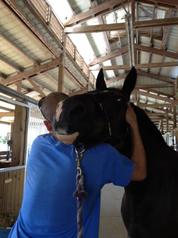 Most athletes , including animal athletes, are constantly dealing with bio-mechanical stressors to our spine, muscles, tendons, ligaments, and joints. In some cases this may increase our susceptibility to injury. Chiropractic care and Acupuncture may help to dramatically improve performance, improve health and decrease the likelihood for injury. Based on hundreds of years of combined existence, Chiropractic Care and Acupuncture are still maintained as two of the largest drug-less and non-surgical healing professions in the world!! Chiropractic and Acupuncture’s holistic approach to health and wellness is centered around the body's ability to self restore and heal. The practice of Chiropractic and Acupuncture focuses on the relationship between the structure and the function of the body and how that relationship affects health. Archeologists determined that Neolithic man, 8000 years ago used a primitive type of acupuncture tool called the bian-shi. It is a pyramidal shaped stone used to lance boils and stimulate certain points on the body to relieve pain. Later a sharp piece of bone was used for the same purpose and during the Shang Dynasty (1600 BC to 1100 BC), the metal acupuncture needle was invented. As they tracked their clinical results, they discovered acupoints with similar functions formed a line on the body and the sensation of the de - Qi would follow a certain pathway...a meridian or Jing-Luo.
There are 12 paired regular channels that relate to the organs and 8 extraordinary channels, 2 of which follow the midline. The Governing vessel on the dorsal midline and Conception vessel on the ventral midline. There are also collateral and divergent channels that are smaller branches of the major meridians that link the organs and meridians to one and other to form an intricately connected pathway throughout the body. I use 3 kinds of acupuncture in my practice : dry needle, electro and aqua acupuncture. Dry needle is simple insertion of small acupuncture needles. During electro acupuncture, the needles are connected to a battery powered stimulator to deliver a painless low voltage current to the meridian. For Aqua acupuncture, I inject a small volume of vit b 12 or glucosamine into the point. This causes a small blister and gives continual stimulation over a few days. Life with ponies is not always smooth sailing. One day they are superstars, the next they are dumping the kids in the ring. Some are tough as nails while others are hot house flowers. The key to a healthy and happy life with ponies is balance and Traditional Chinese Veterinary Medicine is one way to help. TCVM theory is balancing the the Yin and Yang in body and mind for health and happiness. Yin and Yang are opposing forces, hot and cold, dark and light, sympathetic and parasympathetic. TCVM has 5 branches, Acupuncture, Herbal Therapy, Tui-na Therapy, Food Therapy and Qi-gong practice. Acupuncture uses needles or laser to stimulate acupuncture points. Many points are at areas dense with nerves and vessels and some are in trigger points of the myofascia. Stimulation alerts cells to release chemical messengers that flow though the body and tell cells in other parts of the body to react. Veterinarians can use their knowledge of acupuncture points and their actions to help the body heal itself. Some examples of these actions are to release endorphins to reduce pain and decrease anxiety or to release nitric oxide to dilate blood vessels or to release histamine which mobilizes white blood cells to help fight off infection. Acupuncture is often described as energy medicine and indeed it is. We have many different forms of energy flowing through us. Depolarization of neurons by chemical gradients, like a battery, cause electrical impulses in our brain and spinal cord to control our sympathetic and parasympathetic nervous systems which control all our body’s functions like breathing, heart beating, hormone balance, thought and movement. We have chemical energy in our cells breaking down molecules from the food we ingest and transforming it to the building blocks of our bodies. We have kinetic energy in our DNA that winds and unwinds to control translation, transcription and protein synthesis. By using acupuncture to stimulate or calm these reactions, we can balance the whole body from the macroscopic to the molecular level. Chinese Herbal Therapy uses formulas developed for medicinal purposes made from a variety of plants, roots, fungi, minerals and animal products. In modern herbology, most formulas are vegan and we do not use products such as rhino horn or deer antler velvet but some formulas contain insects, shells or bone from commercial livestock like cows, pigs and chickens. Most of our modern day pharmaceuticals are derived from plants and animals but then isolated and highly concentrated so they have a specific action, are stronger, work immediately and can have strong side effects. Herbal therapies are slower to work and gentler on the system because they have a wider range of action and the formulas are balanced to counter act the side effects that herbs in the formula may cause. They come in powder, pill and biscuit forms. Herbs are not supplements, they are medicine so they may be given for a short duration for an acute problem like hives or an upper respiratory disease or may be prescribed for longer periods for chronic disease like cancer, arthritis and for geriatric patients. Tui-na therapy is Chinese physical therapy. Chiropractic Care and physical therapy techniques have their roots in Tui-na techniques. Joint manipulation, stretching and massage techniques are used to restore range of motion and decrease pain and stiffness. The spinal nerves exit the vertebral column between a canal made by a pair of adjacent vertebrae. These nerves transmit signals to all parts of your body to control muscles, organs, heart rate, ect. If these vertebrae are not moving freely or moving too much, this canal can change shape and squeeze or pinch the nerve. You are aware of muscle contraction and pain but proprioception (the way your brain knows where your hands and feet are) is caused by information gathered at your extremities and sent back to your brain. You are not actively telling your heart to beat, your lungs to breathe or your intestines to digest food but any blockage in nerve conduction to these organs can cause systemic problems. In modern practice, Chiropractic care is performed by a DC or DVM to restore the normal motion of the joints. The massage and stretching portions of Tui-na can be done by the owner on a more frequent basis. You may be doing some Tui-na techniques already if you use a curry, hay wisp, rub down legs, do tail pulls or carrot stretches in your grooming routine. So your pony club DC was right, grooming is the first step to good health ! Food therapy is based on the energetics of foods and we classify them on different tastes. A good rule of thumb is crisp, refreshing foods such as cucumber, celery, watermelon rind and radish are good for Heat conditions. Warm foods are ones that take energy to digest so oats, sweet potato and pumpkin can help keep your pony warm in winter. Neutral foods are bland like potato, corn, cabbage, apples and carrots. The more processed a food is, the more heat it contains so raw is cold, while extruded nuggets are hot. Most ponies don’t need more than hay but you can supplement his diet seasonally with foods based on temperature. More in depth food therapy decisions are based on the 5 tastes : Sweet foods tonify the Qi(give you energy), which makes sense because they are filled with carbohydrates. Sour foods tonify the liver and helps regulate fluid balance. The sour tasting foods are the citrus fruits, rose hips, green tea, pomegranate which are antioxidants. Some sour foods contain tannins like dark beer which may help increase sweating and help grazing animals digest foods with high soy content. Bitter foods Tonify the Heart (circulatory and nervous system) and Clear Heat (reduce inflammation and infection). These are plants containing glycosides and alkaloids. Some common drugs made from plant glycosides are aspirin(anti inflammatory, anti pyretic), morphine (pain relief and sedation), quinine (antimalarial antipyretic) and digitalis (regulates the heart rhythym). Astringent foods are associated with the Metal element ie Lungs, skin, reducing mucous and opening the airways. Acrid foods have a burning feeling on the tongue because they contain essential oils like ginger, mentha, mint, cinnamon, and corriander. Salty foods Tonify the Kidneys and softens masses so we use salty foods in cancer patients, thyroid disorders, constipation and geriatric patients. Seaweed such as kelp and laminaria are commonly used. Qi-gong translates to Life energy cultivation. It is similar to Tai Qi by using gentle movements, breathing and mediating to relax the body and mind. Stress produces cortisol, an endogenous steroid that increases blood sugar, suppresses the immune system and decreases bone formation. So you ask, how do I get my pony to meditate ? We all know when we have a bad day you should just not ride because your pony will be bad and you will leave the barn frustrated. Horses are very in tune to our feelings and emotions. My suggestions for pony mediation are to do your grooming/Tui-na sessions with a relaxed attitude and rhythmic breathing, take a long trail walk on a loose rein enjoying nature or try centered riding. Incorporating TCVM practices into your pony’s daily activities is easy to do when you know a few basic theories and can help you live a long and happy life together. 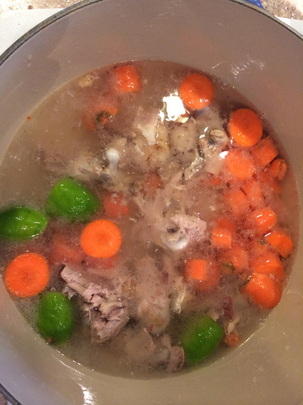 Bone Marrow Soup I talked about this on the Driving Radio Show this week. Here are some step by step instructions. I always encourage my clients to cook for their dogs and cats but just like cooking for yourself and your family, it usually takes a big health problem to make the change from processed foods to fresh home cooked. Its ok to start slow. Even if you don't want to or can't cook every day. Fresh foods as treats or a few days a week is a great starting point. Ingredients : Marrow bones Turkey Thighs 1 lime 1 TB apple cider vinegar 3 cups of chopped root vegetables Carrots, squash, beets, celery - I used carrots because I always have that on hand :) Directions : Cut long bones to expose marrow. I used a big cleaver and hammer, see photos Put bones, veggies, the juice of 1 lime and 1 TB apple cider vinegar into a large heavy bottomed pot and bring to a boil. Reduce heat to low and simmer covered overnight. You can also do this in your crockpot. As the bones simmer, the acid of the vinegar and veggies extract the nutrients and essence of the marrow. Check water level every few hours and add more water if the bones are uncovered.
Let cool and strain broth. Keep in fridge for up to 1 week. Feed small (start with 2 TBs) frequent meals throughout the day to your sick doggie or kitty. The cooked veggies can also be added to the food if they are strong enough to eat them. This is a great way to get them back eating after an insult, like after eating a week old dead squirrel in the yard, post chemo, post parvo, ect. Variations : you can make this with any marrow bones, beef, pork, even a whole organic chicken. Consult with your TCVM vet to see what protein would be best for your pet. I usually make this with the left overs from Tamika and Rolly's turkey roast, which is just roasted turkey thighs on a bed of chopped green veggies like zucchini, green beans, ect. Roast in the oven @ 350 for 1 hr. When cool, remove the meat from the bones. The bones go into the soup pot and the meat is chopped up and added back to the veggies. I then add in some cooked brown rice, millet or their favorite, red quinoa ! Then mix it all up and I put it in tuperware and store 1 weeks worth of food in the fridge and freeze the rest in 1 week aliquots. When traveling, we freeze individual meals and put them in the cooler and defrost when needed. 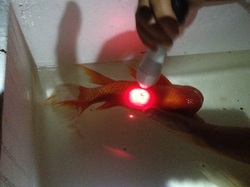 So we have expanded into the garage with our new fish hospital ( 2 laundry tubs, a styrofoam box/treatment tank and a bubbler) ! 2 goldfish were rescued from their old pond by Ben of Myakka Aquatics and are being treated with antibiotics, laser therapy, herbal medicine and a diet of superfoods (kale, watermeal and shrimp). One has a large ulcer on the side and the other has bruising and dropsy. This is my first attempt at treating pet fish but they seem to be responding well. Many thanks to my fish expert friend Charley Gregory (soon to be DVM in the class of 2014 ! ) for all his advice. For more fish info check out Charley's page http://www.healthyaquatics.com/  Autumn is the season for the Metal Autumn is just around the corner, the weather will be cooler and drier. According to TCVM principles, dryness becomes a major problem affecting the metal element. The Metal horse is clean, quiet, confident and disciplined. They like to follow the rules and do not like change. They learn quickly but it is quite a task to train them for a new job. They tend to be aloof. The associated meridians and Zang Fu organs of the metal are the lungs and large intestine. The external orifice is the nose and the tissue is the skin and hair. The metal element is involved with respiration and digestion due to its relationship with the lungs and large intestine but it also is deeply involved with the skin and hair coat and the immune system. As the seasons change from hot humid summer to cooler drier fall weather, the lung can be weakened by the dryness. This leads to symptoms such as dry flaking skin, dry nasal cavity, frequent nose bleeds, sore throat, coughing and constipation. The weakened immune system leaves us open to infection by external pathogens, ie virus, bacteria, mold and allergens. Drinking enough water and avoiding losing too much fluids are always important, but are even more so at this time of year. After a hot summer with numerous reminders to rehydrate, cooler temperatures cause us to take in less water. You don’t feel hot and parched so you drink less. This makes you more susceptable to the effects of dryness as your mucosa in your nose, mouth and throat ( your 1st line of defense against pathogens) dries out and becomes less functional. Symptoms of dryness include impaction colic, respiratory distress of COPD, skin itching, flaking, rain rot, nasal discharge, susceptability to respiratory diseases, decreased energy, cracked hooves and dandruff. So what can you do to prepare for the fall season ? Start with food therapy. Eat more soups, stews or cooked vegetables. This will increase your water intake and cooked food is easier to digest and warming so boosts your qi. Cooked yams or pumpkin with ginger is a good addition to your animal’s diet at this time of year. Pear is also an excellent choice to tonify the lung. Pear reduces cough, relieves dryness and tonifies the qi. Any yellow, orange and/or red foods are good to incorporate into the diet, so bananas, lemons, apples, beets, yams, squash are great to incorporate into the diet. Grief is the emotion of the metal. Your horse may seem sad or depressed with the shortening of the days. This is a time of the year to be reflective. Look over your goals for your horse. Is it time for a rest before the season gears up in the winter early spring or is it time to push on for the finally before the winter ? Organize and make a plan for your metal horse that involves rest or sufficient support to get him through the end of his season. For people, we say now is the time to let go of negative emotions. For horses, they may have more off days than usual in the fall. Maybe it is time for a trail ride rather than dressage school or do shorter sessions with rest and praise in between sets. If symptoms persist, seek additional treatment such as acupuncture, herbal therapy and chiropractic care. An immune supplement such as Standard process immune support can help boost qi and fight off colds. Driving Radio show episode 106 July 17, 2013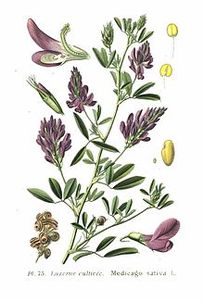 You rescue a starving pony and the first thing you want to do is feed him all the grain, apples and carrots he will eat right ? Well that is very well meaning but can be life threatening for your new little pal because of re-feeding syndrome which is a metabolic crash when the body is introduced to carbohydrates again. (metabolism geeks - see box below) So before your neighbor calls the humane society on you, how do you know if your pony is actually starving or just skinny ? Ask yourself these 3 questions. 1. Is he a body condition score of less than 3 ? 2. Has he eaten any food in the last 5 days ? 3. Has he lost more than 15 % of his body weight within 2 months or less ? If you answered yes to any of these, call your vet, resist temptation to deworm and vaccinate for 2 weeks, get some probiotics and follow the rule "go low and slow ". Low sugar and carbohydrates and multiple small meals throughout the day gradually building up to free choice food over 14 days. Feed a high protein low carb food, like Alfalfa and make sure he has access to fresh, clean water and salt. Day 1-3 Feed 1 lb (1/4 flake) of alfalfa hay every 4 hours. Day 4-7 4 lb about (1 flake) and decrease the frequency of feeding to every 8 hours Day 7-14 Continue feeding at this rate while slowly increasing the amount and decreasing the frequency until the horse is receiving all the hay it wants in a day. If feeding grass hay, feed 2x the amount at the same rate. At the end of 2 weeks you can introduce grain. Choose something with high fat, high fiber, low starch, low sugar. Senior feed is best as it is nutrient dense, high fat and easy to chew. Feed ½ pound of concentrate twice a day then increase grain by ½ pound a day every 3 days until the horse is being fed ½ to 1 pounds of grain per 100 pounds body weight per day in 2 feedings. So a 500 lb pony will be eating 5 pounds of senior feed per day. A safe rate of weight gain is about 1 lb per day. Make sure to have your vet or a friend who does not see your pony every day asses your progress. At the end of 2 weeks you can now work on his other problems which may include any and all of the following :
Choose one problem at a time to work on as you peel the layers of the onion away on your road to recovery. Start with parasites and just assume this pony has never seen any dewormer in his life and is full of worms. On day 14, give ½ dose of one of the paste dewormers containing one of the Here again, resist the "more is better " approach and buying the best dewormer there is that kills everything. Intestinal parasites in horses live in various stages in the body. Some are imbedded in the tissues, some are living in the gut lumen and some are eggs on their way out to infest your pastures. You want to start with fenbendazole (Panacur or Safe-guard) which is a mild dewormer because it only kills the adults in the lumen of the intestines. Killing all the larva lurking in the tissues can lead to an inflammatory reaction in the gut leading to colic and laminitis. Day 14 - 1/2 dose of Panacur Day 21 - 1/2 dose of Panacur Day 28 - full dose of Panacur Day 42 - 1/2 dose of Ivermectin Day 56 - Power Pac - 5 day treatment of Panacur then continue on a maintenance deworming schedule The theory behind this schedule is to kill off the parasites in the gut and then wait a week to let some larva emerge, kill off the next round and treat again so you are treating the wave of emerging parasites. The Ivermectin kills bots (fly larve in the stomach) and thread and neck worms that cause inflammation in the skin and eyes. The 5 day power pack kills the rest of the larva (encysted strongyles) which hopefully by now are down to a reasonable number and will not cause an inflammatory reaction. Of course this is a general guideline so consult with your veterinarian so you can decide whether your pony is ready for this treatment. Some things to consider : Dos
Don'ts
Re-feeding syndrome - occurs when a starved horse is fed too quickly during his rehabilitation. During the period of starvation, the body goes into a state of ketosis and uses fats for its main source of energy because it doesn’t have carbohydrates. Ketosis changes the electrolyte balance in the cells and depletes the body’s stores of essential minerals like phosphate, potassium and magnesium. Because the animal is not eating, he can not replenish these stores. If carbohydrates are introduced too quickly, the body releases large amounts of insulin to process the carbs. Carb metabolism requires large amounts of phosphate, potassium and magnesium but because the starved animal is running on empty already, he suffers symptoms related to electrolyte depletion like heart palpitations, respiratory distress, paralysis, organ failure, confusion, and weakness. This occurs in all mammals but in horses some of the consequences can also include laminitis (founder) and rhabdomyolysis (tying up).
This condition was first fully understood in people in 1950 when prisoner of war veterans who were malnourished in captivity were released back to the American military and is a common consequence in anorexic patients. |
�
Dr. WendyPractices Traditional Chinese Veterinary Medicine in Sarasota, Florida Categories
All
Archives
December 2023
|
|


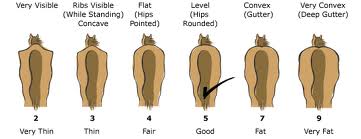
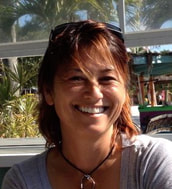
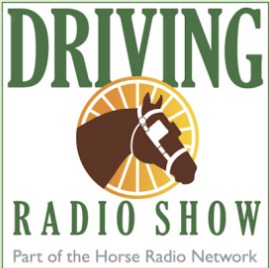
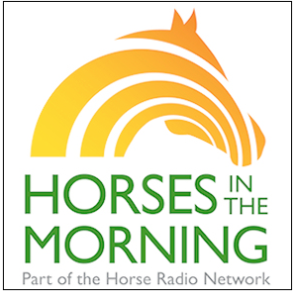
 RSS Feed
RSS Feed

